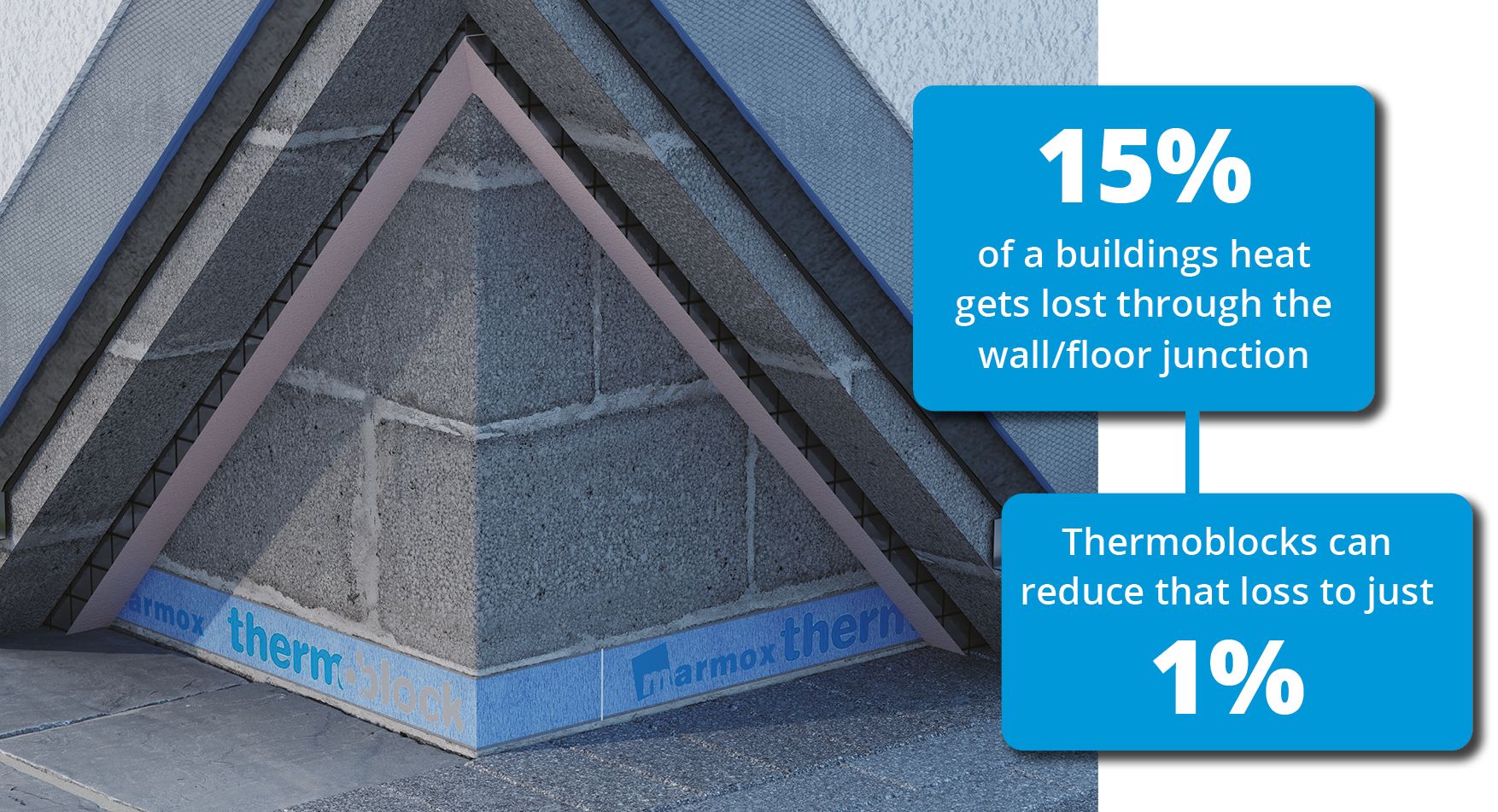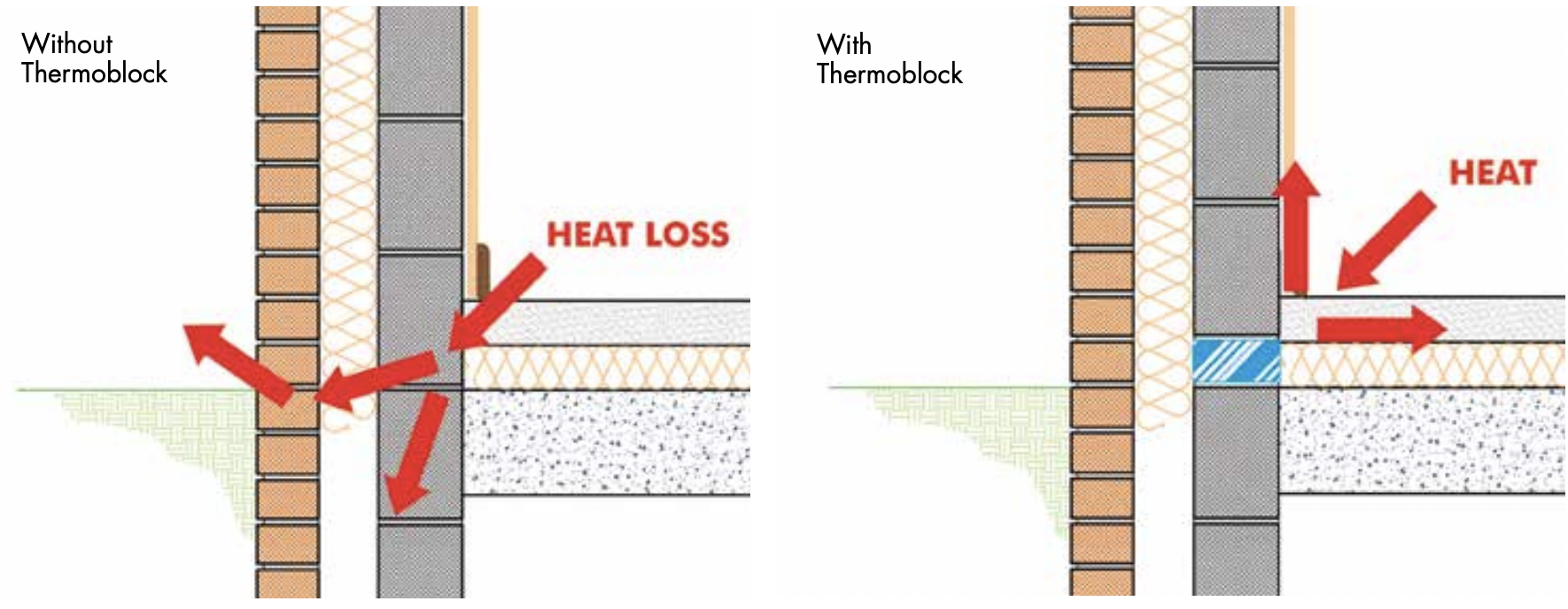When we think of insulation we usually picture adding it to a roof in the loft, but did you know that 15% of a buildings heat gets lost through the wall/floor junction? Marmox Thermoblocks can reduce that loss to just 1% - read on to find out more about these innovative insulating building blocks.

What is a Marmox Thermoblock
Marmox Thermoblock is a block of load-bearing insulation material designed to be placed at the base of a masonry or timber–frame wall. Its thermal conductivity is 0.05W/mK which will result in a significant reduction in y values when used at wall to floor junctions.
The standard Marmox Thermoblock comprises of a 60mm thick core of fire resistant XPS insulation encasing two rows of high strength, low conductive, epoxy-concrete columns. These are fixed to the top and bottom surfaces of the block, which are 2.5mm thick layers of fibre reinforced polymer concrete incorporating the latest innovation in building technology – Carbon Nano Tubes.

Does Marmox Thermoblock comply with building regulations
Building regulations in the UK state: “The building fabric should be continuous over the whole building envelope and constructed so that there are no reasonably avoidable thermal bridges in the insulation layers caused by gaps in the various elements.” Thermoblock connects the wall insulation with the floor insulation, providing guaranteed compliance to the regulations.
Installing Marmox Thermoblock
Marmox Thermoblock can be used in a wide range of building projects, with slightly different installation methods for each. We recommend reading the Marmox Thermoblock Technical Datasheet for detailed instructions on how to use them correctly
- Masonry Cavity Wall junction with a ground floor
- Masonry Cavity Wall junction with a block and beam floor
- Timber Frame Wall junction on ground floor
- Underneath a concrete slab, below a timber frame
- Underneath a solid wall
- Underneath a threshold
- Underneath a door threshold
- Internal and party wall junction to the floor
- Wall junctions with non-ground floors
- Roof eave to wall junction
- At the base of parapets
- At the base of an ICF wall
Marmox Thermoblock Frequently Asked Questions
How do I seal the blocks together?
Marmox MSP360 sealant should be used to seal the ends of the Thermoblocks together to prevent moisture creeping up between blocks and to ensure air tightness of the building.
Is Thermoblock an alternative to aircrete blocks?
Thermoblock should be used with, not instead of lightweight aircrete / thermal / AAC blocks. These blocks typically provide λ values between 0.11W/m.K (for 3.6N blocks) to 0.22W/m.K (for 7.3N blocks) whereas the Marmox Thermoblock’s λ value is 0.047 W/m.K.
Is Thermoblock an alternative to a DPM?
Although when sealed together Thermoblock creates a permanent waterproof barrier, a Damp Proof Membrane must be applied to the detail as though the Thermoblock were simply another normal block in the wall. The DPM can be fixed above or below the Thermoblock layer.

Can a Thermoblock be laid on top of each other?
No. All independent testing has been carried out with just one course
of Thermoblock – we are unable to provide a characteristic compressive strength when more than one layer is used. In nearly all situations, the 65mm high version is sufficient in reducing the y value however a 100mm high version of Thermoblock is also available if necessary.
What is fixed above or below the Thermoblock must NOT be narrower
Thermoblock derive their strength from rows of concrete columns located along each side. What is sitting on top of a Thermoblock must therefore distribute its weight evenly over both sides. In other words, what’s on top (and below) the course of Thermoblock must not be narrower than the width of the Thermoblock.
Can it be used as a Cavity Barrier?
No, if used to bridge two combustible insulation materials the core material could melt creating a conduit for flame to enter one living space from another. Therefore a cementitious covering such as a cement board should be fixed to one of the sides.
How are Thermoblocks installed?
Thermoblock can be cut on site using a brick saw, or through the polystyrene-only sections with a hand-saw. They are laid using ordinary bricklayers’ mortar.
You can order Marmox Thermoblock online at Tile Fix Direct with next day delivery.

